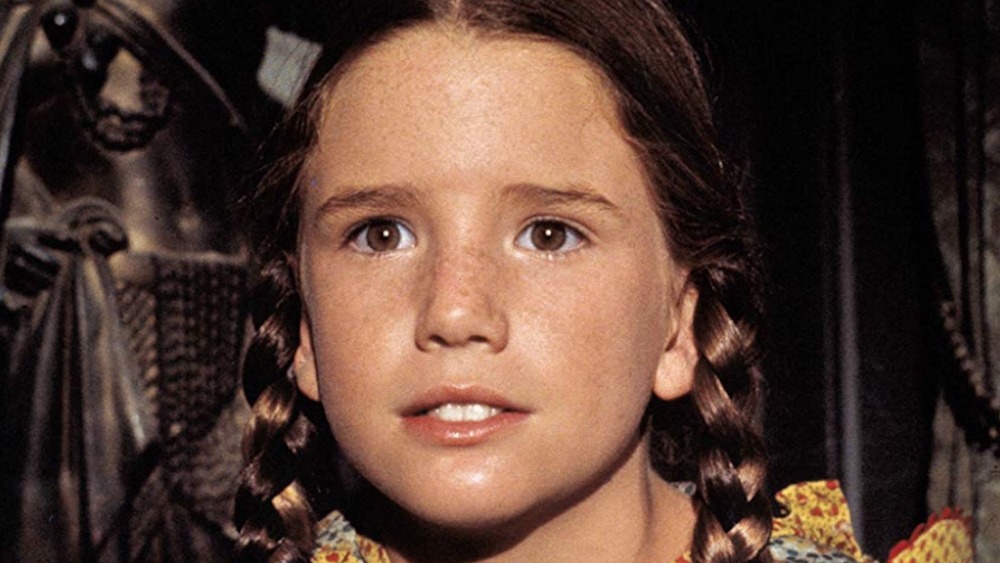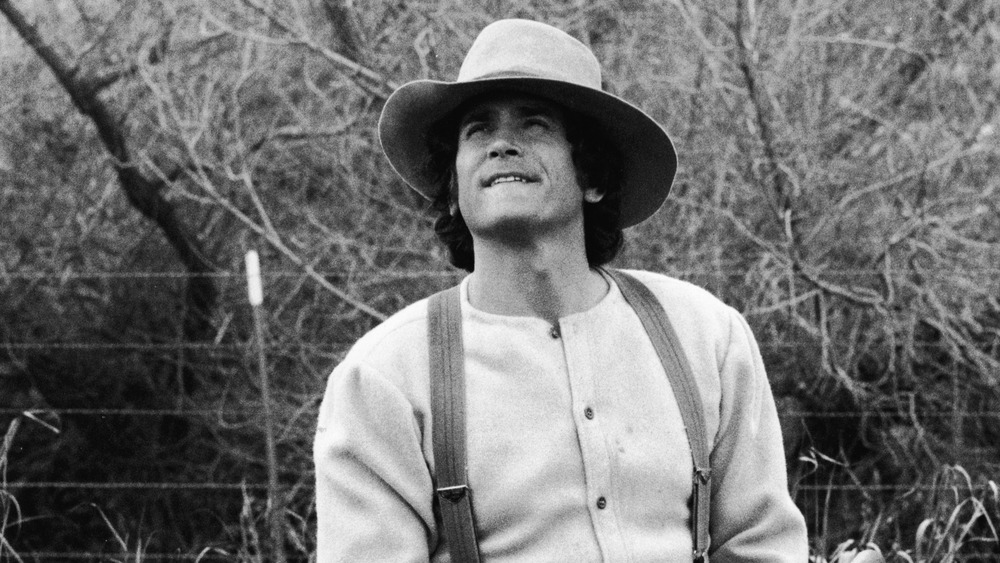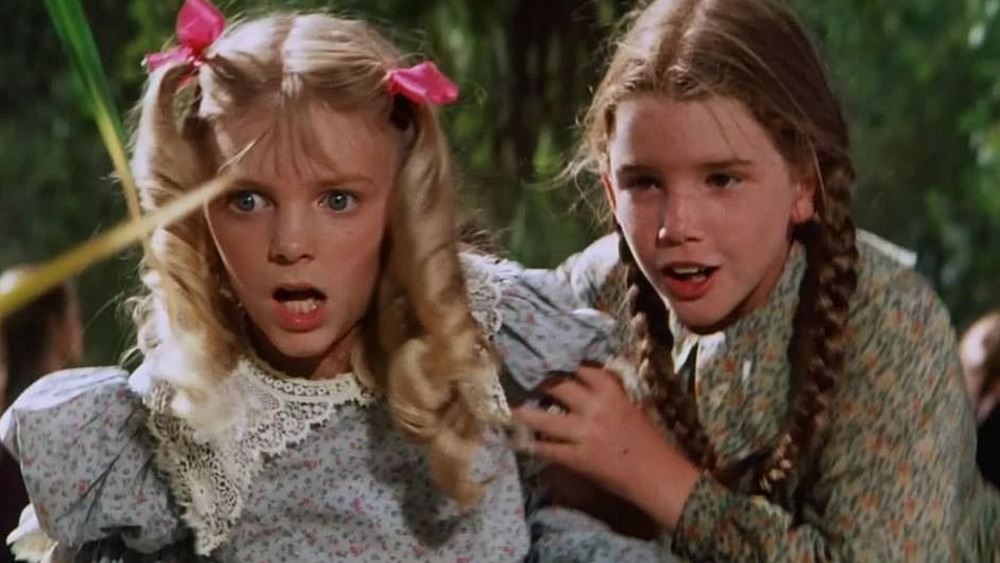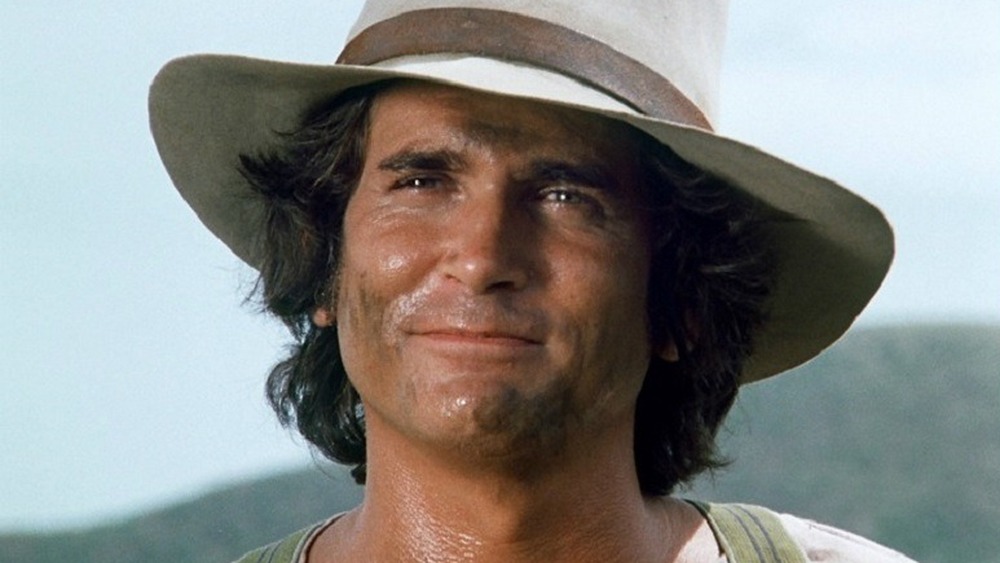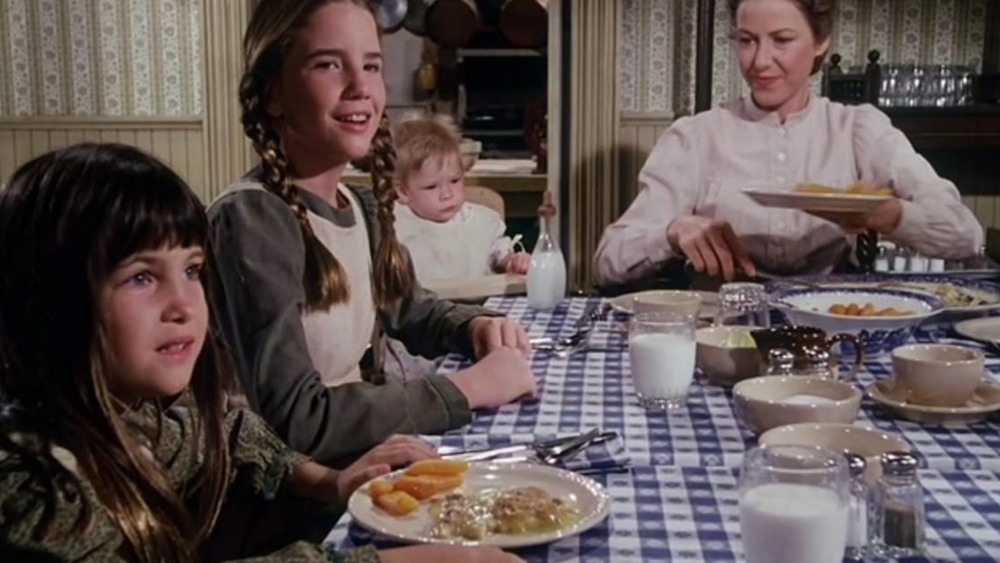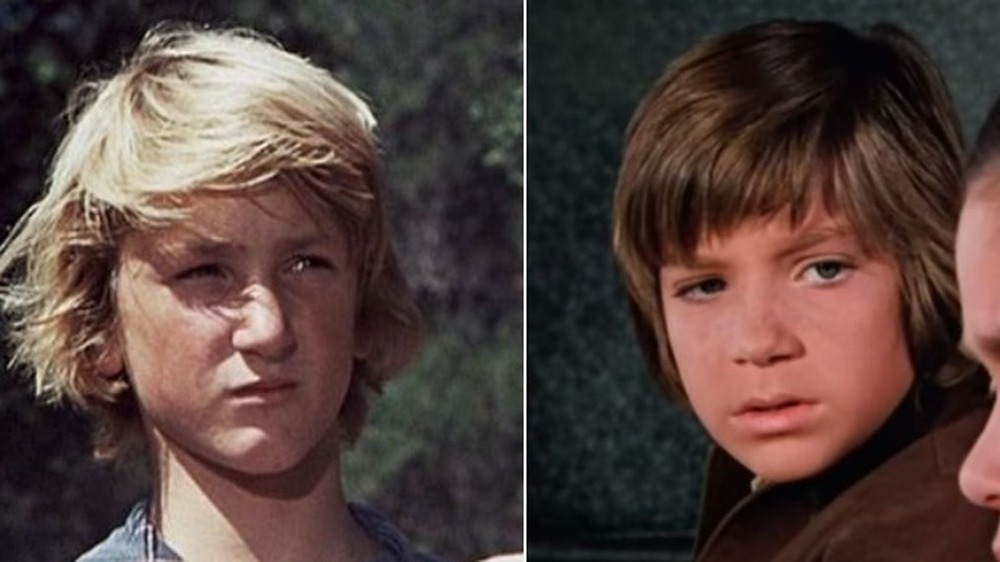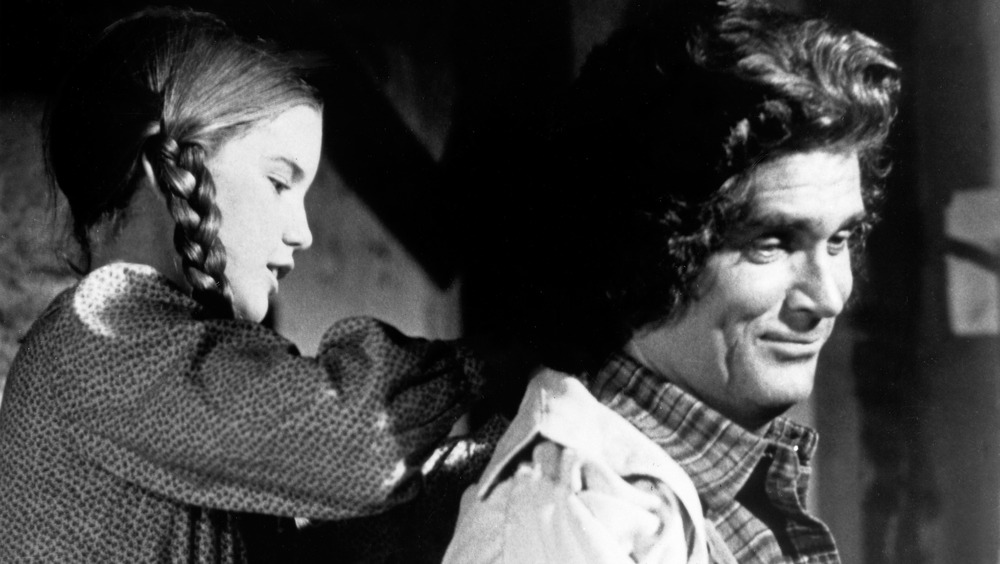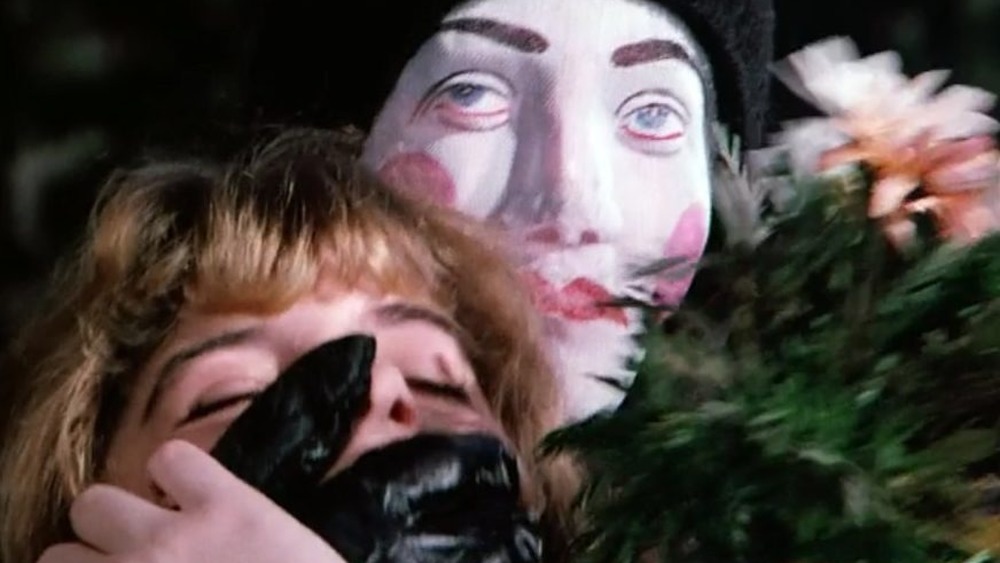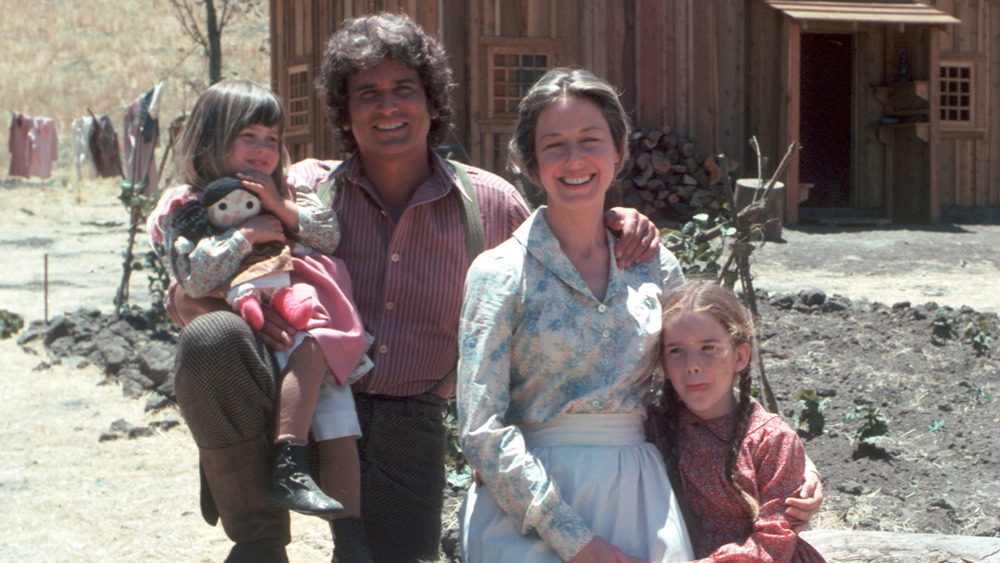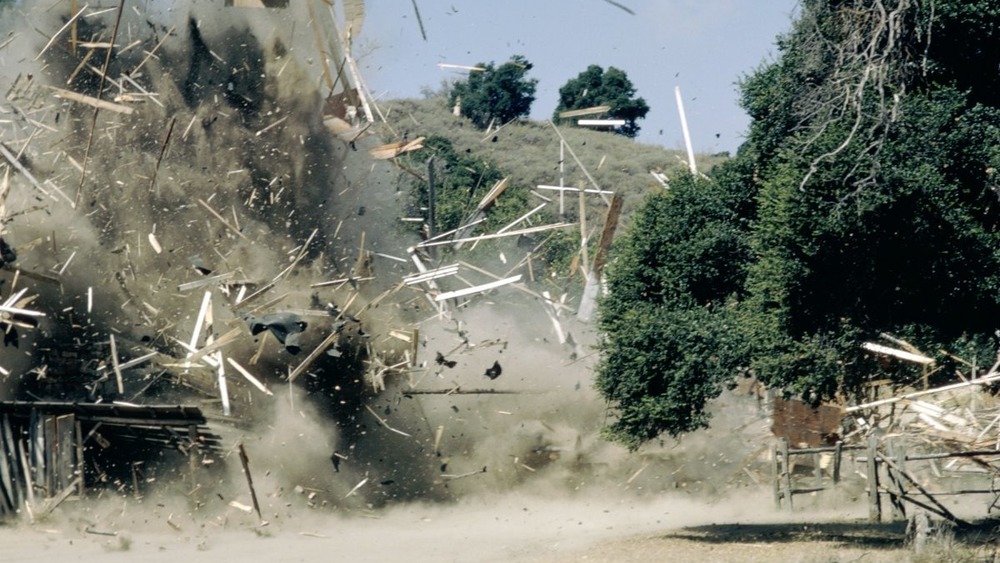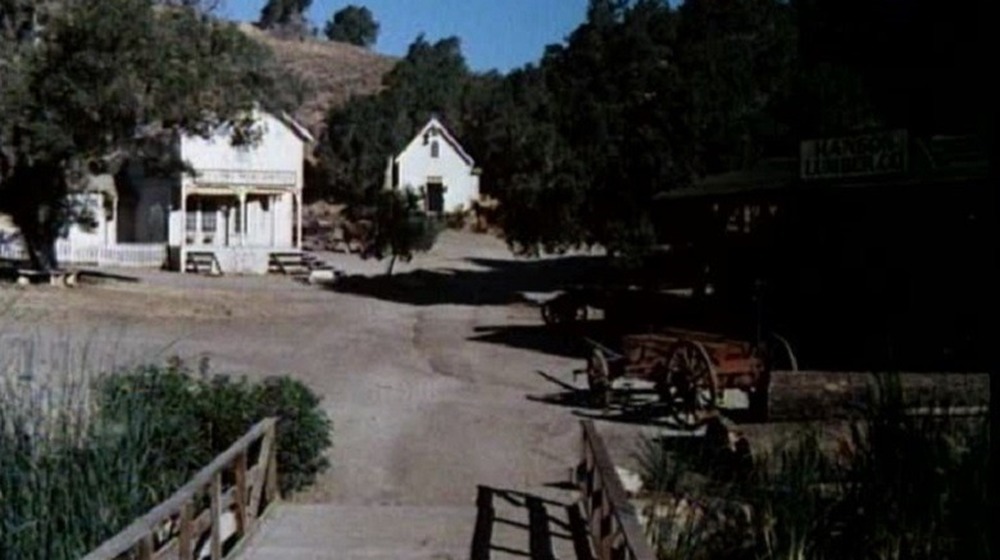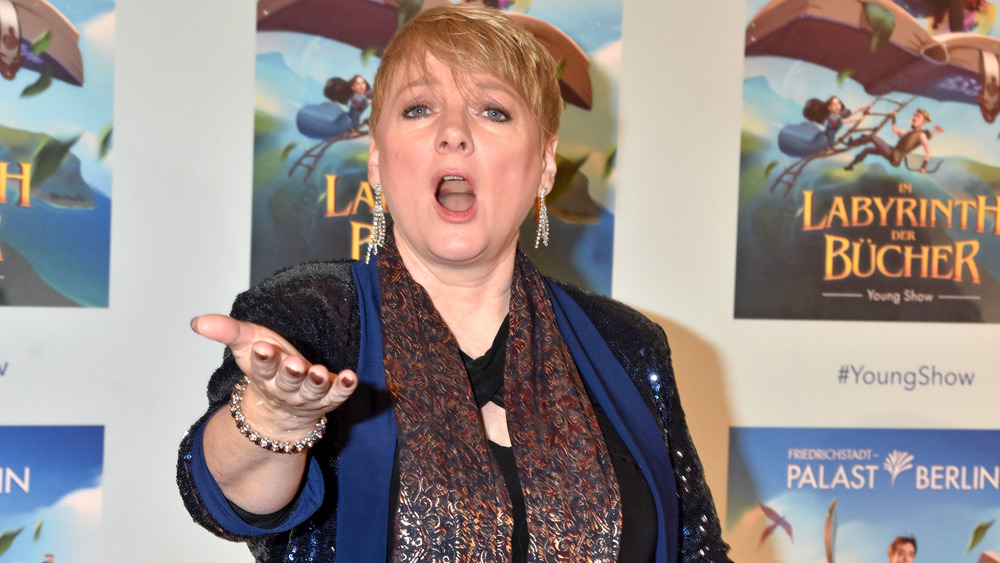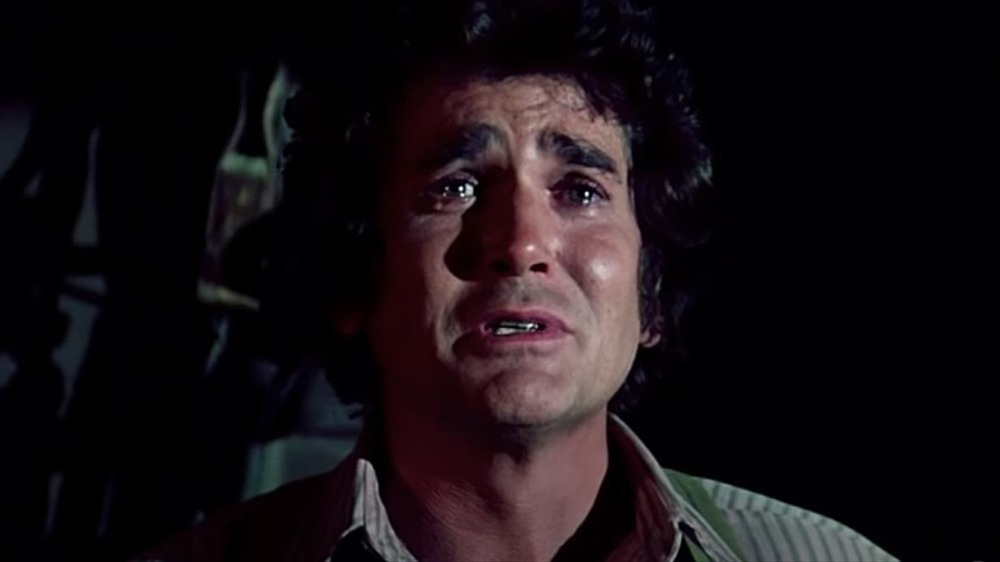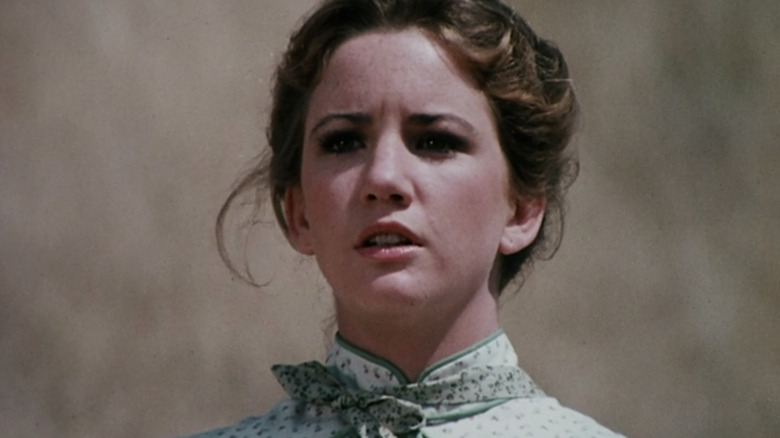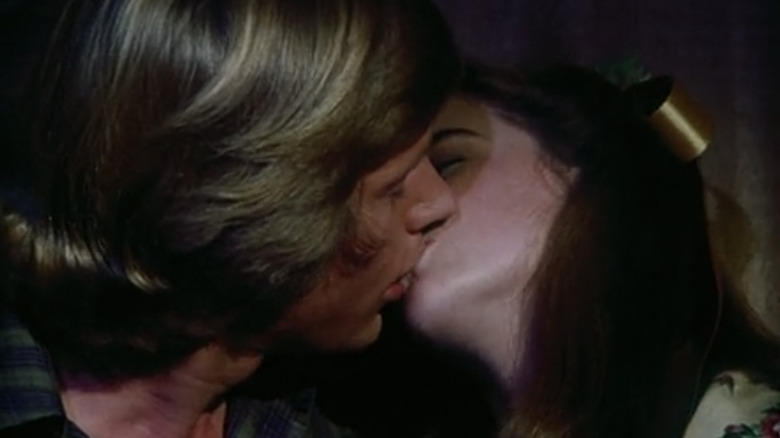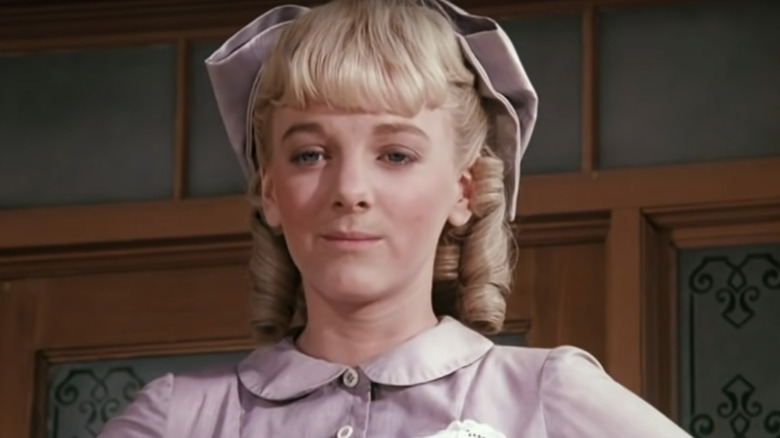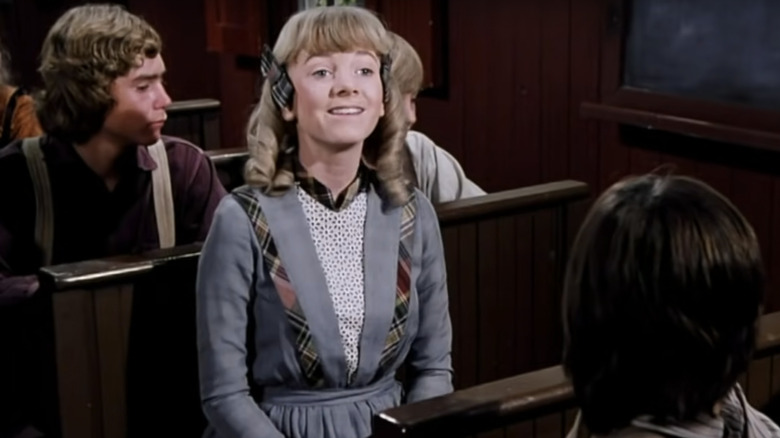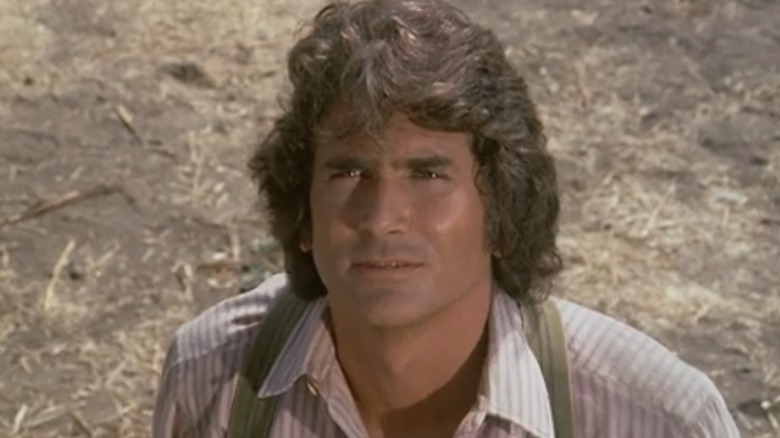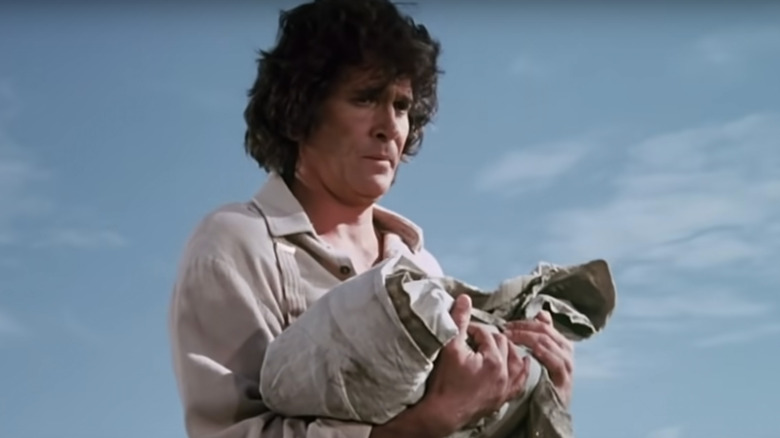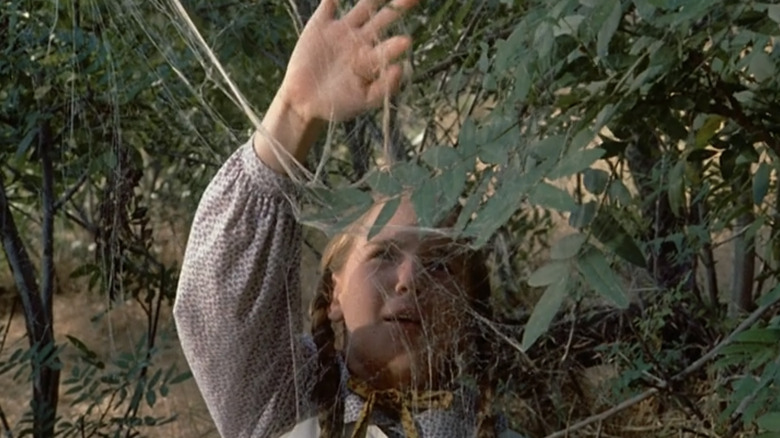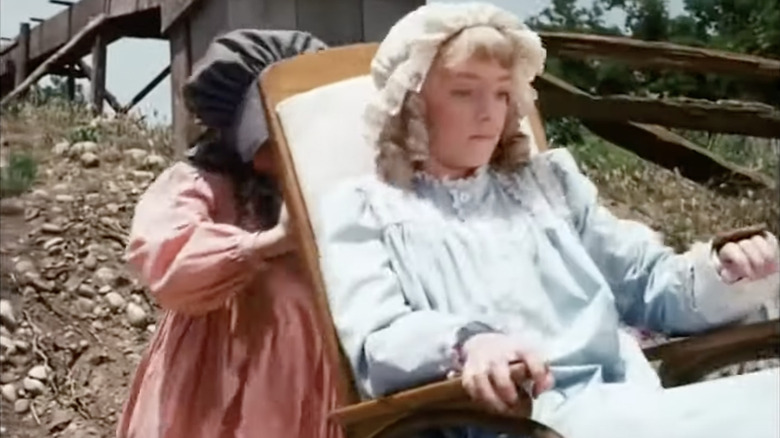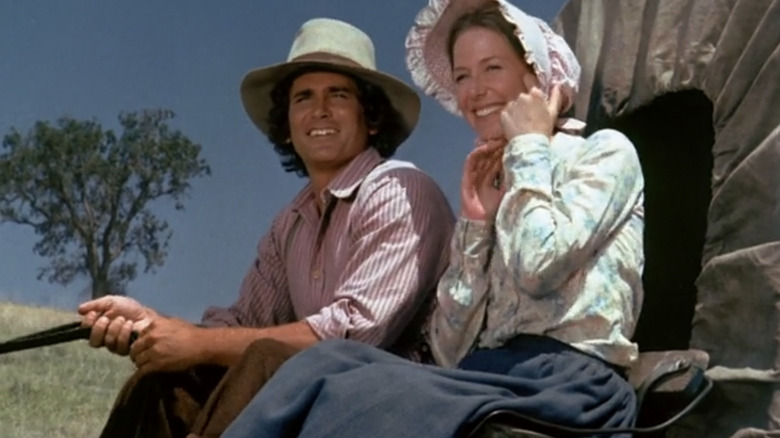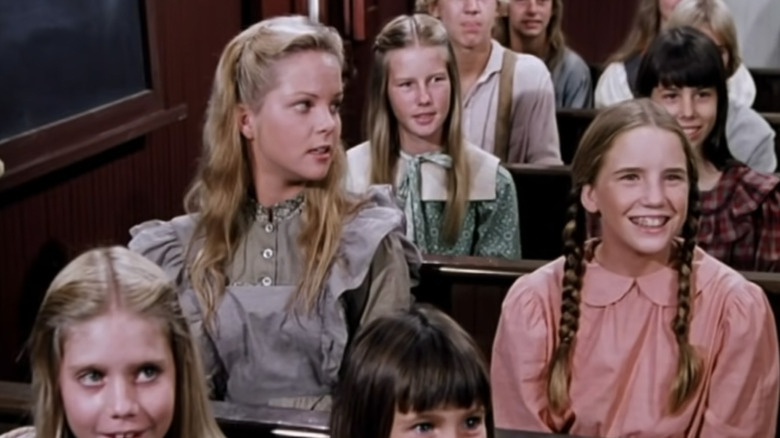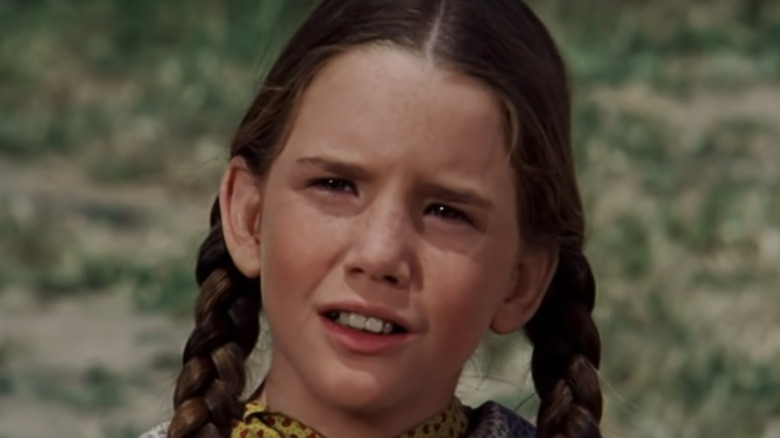The Untold Truth Of Little House On The Prairie
Based on the classic children's novels by Laura Ingalls Wilder, "Little House on the Prairie" left a huge mark on a lot of our childhoods. Over the decades, the show has carved out its own cultural niche, and with nine seasons — and years of reruns — "Little House" has found a huge audience.
In fact, fans of the show appreciate it for a variety of different reasons. Some, affectionately called "bonnetheads," like the historical setting and the wholesome family vibe. Others just sit around with buckets of popcorn, waiting to see what wild thing might happen next on a show that often delights in melodrama and the hilariously bizarre. And more than a few just have hoped that Michael Landon would take his shirt off again.
And with such a popular series, it should come as no surprise that there are quite a few behind-the-scenes stories and fascinating facts for diehard fans. From backstage trivia and secrets of the show's success to its lasting place in viewers' hearts, there's a lot to talk about when it comes to examining the untold truth of "Little House on the Prairie."
Michael Landon's vision dominated Little House on the Prairie
"Little House on the Prairie" had Michael Landon's stamp on it from the beginning, and he exerted a lot of creative control over the show — so much, in fact, that he reportedly drove away Ed Friendly, his co-executive producer. In a 1974 interview with People, Friendly complained that Landon had no business being a writer or producer. He thought Landon strayed too far from the books in giving the Ingalls family an easier life. As he said, "I've renamed the series 'How Affluent Is My Prairie?' They have everything but a Cadillac."
But for some, Landon's cozier vision was a draw, and the show was a fine expression of his warmer side. Cindy Landon, his widow, told Closer, "If you watch 'Little House,' truly it was like watching Michael. The love that he had for his family, the type of person he was — it was all apparent." She wasn't alone in thinking that. In an interview with CBS, Melissa Gilbert said without hesitation, "The show's values ... were absolutely a reflection of the values of our leader, of Michael Landon. He was that man. He believed that people are always really good at heart."
When "Little House on the Prairie" serves as comfort viewing, viewers are responding to Landon's better nature. He might've sacrificed historical accuracy and sanded the rough edges off of prairie life, but he also provided the show's sense of heart and made it something viewers still find reassuring.
Laura's worst enemy was Melissa Gilbert's best friend
Laura Ingalls was always butting heads with Nellie Oleson, but whenever the cameras weren't rolling, actresses Melissa Gilbert (Laura) and Alison Arngrim (Nellie) were inseparable. When they were off the set, that closeness could confuse loyal "Little House on the Prairie" viewers who couldn't see that there was a thick line between fiction and reality. As Melissa Gilbert said at EW's cast reunion, "The two of us would go places together, and people would try to protect me from her. Even when I was ten, I'd want to say, 'Come on, it's a TV show.'"
People expected to see Melissa Gilbert being chummy with the other Melissa — Melissa Sue Anderson, who played Mary, Laura's sister. But the two were never that close. In an interview with AJC, Anderson put it tactfully, saying, "I honestly do not have a lot of memories of the two of us. We were very, very different." She was a lot quieter and, in her words, less "zany" than Arngrim and Gilbert. So in her case, the TV show persona was a little more accurate. Mary was always the best-behaved Ingalls sister.
At the cast reunion, Alison Arngrim joked about the same character-actress parallel. "[Anderson] looked at us like we were total juvenile delinquents. I think she thought we would get her in trouble if she hung out with us, which is perfect for her character because Mary was such a little narc."
Behind the scenes, the show was full of pranks
Michael Landon asked everyone on the show to work hard. Rachel Greenbush, one of the twin actresses who played young Carrie Ingalls, reminisced in an interview with Closer that, "When it was time to work, you had to be focused."
But when it wasn't time for work, it was time for play, and the play could get as enthusiastic and goofy as anyone could possibly want. Inseparable buddies Melissa Gilbert and Alison Arngrim were constantly playing together. At a cast reunion, Gilbert talked to EW about how she and Arngrim used to organize "some epic games of tag and Red Rover."
However, the kids' fun had nothing on what the adults could get up to. One of Melissa Gilbert's favorite stories to recount in interviews has to do with Landon's go-to trick for "marriage security." During the show's run, Landon was an undeniable heartthrob, which may be the answer to why Pa Ingalls spent so much time shirtless. But while Landon was happy to convert crushes into ratings, he didn't always like fans hanging around the set ogling him. Luckily, he had a surefire trick to drive them away. Gilbert told Entertainment Weekly, "I'd catch frogs, and Mike would put the frogs in his mouth and walk over to people and talk, and then the frogs would jump out. ... [The women would] always scream." No kidding.
That home-cooked food was anything but
If you've ever watched "Little House on the Prairie" and pined for a taste of that pioneer cooking, getting it could be easier than you think.
Putting food on the table might've been hard work for Ma Ingalls, but behind the scenes, the show kept things simple — and cheap. When Melissa Gilbert spoke with Parade to promote her new cookbook, she revealed a backstage tidbit that made it clear none of the recipes in her book could've stemmed from the show because what they were really eating wasn't home cooking by any stretch of the imagination. Those Ingalls family dinners? Dinty Moore beef stew and Kentucky Fried Chicken, with a side of Pillsbury biscuits. Suddenly, that kitchen table looks a lot less like a romantic vision of times gone by.
But even if those dinners came together by virtue of a drive-thru window and a quick trip to the convenience store, the results weren't too shabby. At least not according to Gilbert, who admits, "I was always the first one eating the extra food. I would just gorge myself!"
Sean Penn and Jason Bateman debuted on the show
Before they became major movie and television stars, Sean Penn and Jason Bateman were child actors, and they both got their first break on "Little House on the Prairie."
Penn's first role is easy to miss, especially since he was uncredited. He was just one of a handful of unnamed extras who helped fill out the town of Walnut Grove. It's easy to see how he wound up with the part, though. His father, Leo Penn, was a longtime TV director who worked on numerous '70s and '80s shows, and little Sean Penn's onscreen appearance was in one of his dad's episodes, "The Voice of Tinker Jones." How's that for a "Bring Your Kid to Work Day" experience?
Bateman, on the other hand, was an actual character on "Little House." Starting in the seventh season, he played James Cooper, an orphan the Ingalls family takes in. (He was one of several, actually. Fans will fondly remember that the show liked its orphans.) The role — which he continued for 21 episodes — kicked off his long-running and tremendously versatile career, with Bateman moving back and forth easily between not only movies and TV but also comedy and drama.
Little House on the Prairie was a good place to be a child actor
Being a child actor can be stressful, and plenty have burned out or chosen to walk away from the business entirely. Since "Little House on the Prairie" was a family show that starred several young actors, its behind-the-scenes legacy could involve horror stories about kids asked to shoulder too much work too soon.
But that's not the case. The one-time child actors of "Little House" speak about their experience with real warmth. Why? Well, for one thing, there was fun – games, crafts, and birthday parties complete with cake. It was also a creatively and professionally rewarding experience, which meant a lot to the young actors. In an interview with Parade, Melissa Gilbert said, "We were treated as [kids], but then there were moments when we were actually shooting that I was treated no different than the adults. I was an adult contributor to an artistic endeavor. It was incredibly validating."
Michael Landon had a gift for finding the right balance between offering support and demanding professionalism. And he knew how to adjust his standards for kids. He didn't ask for more than they could give. According to Albert actor Matthew Laborteaux, who spoke to EW, "As long as you showed up on time, knew your lines, worked hard, and, you know, gave a s***, you were aces in his book." In a world full of rough starts, "Little House" seems to have offered a smooth runway and left its cast with fond memories.
Nine seasons gave the show time to wander off to some weird places
Even back in 1974, Michael Landon was pointing out to People that the show needed to generate a lot of material — more than the seven books they'd optioned could reasonably give them. To fill up nine seasons, they had to get creative.
And in the quest for new ideas, the writing team ventured into some strange territory. The most infamous episode is probably "Sylvia," which features a terrifying attacker in one of the world's creepiest masks. At least it took seven seasons to get from Wilder's beloved children's novels to "mime rapists." While that's probably the highlight — or lowlight — of the show's inventiveness, it also offered diversions that included circus fat ladies and adopted orangutans. And, as if determined not to be topped by anything that went before it, the show also made sure to have a literally explosive finale, as Walnut Grove's citizens blew up their own town.
But this weird soap opera quality is one of the things that makes "Little House" endure. It was family fare that also came with classic primetime melodrama. The show managed to have as many water cooler-worthy twists as "Game of Thrones," and fans are still boggling over some of them.
This quintessentially American show was popular in both France and Spain
"Little House on the Prairie" seems like it should be classic Americana, the kind of show that's barely comprehensible to countries that don't have some general cultural nostalgia about pioneer days. But as it turns out, the series thrived with at least some European audiences.
When it was airing, the show was a hit in Spain. The TP de Oro, a Spanish television award, recognized "Little House" multiple times. In 1976, Karen Grassle won for Best Foreign Actress for her work as Caroline "Ma" Ingalls, and Michael Landon took second place as Best Foreign Actor. The series also won that year for Best Foreign Series as a whole. And in 1980, Melissa Sue Anderson — Mary Ingalls — took home the Best Foreign Actress award.
Sometimes countries even recognize themselves in the series. Bratty Nellie Oleson is a huge hit in France. Alison Arngrim is sometimes there for three months, making the rounds of public appearances and meeting adoring fans. She's one of them. As she said to The New York Times, her French fans "don't think [Nellie's] mean. They just think she's French."
Walnut Grove was always destined for destruction
"Little House on the Prairie" built up Walnut Grove as a home away from home for viewers, a cozy little town — albeit one unusually plagued by drama. It's a little jarring, then, to get to the last episode and find that the show concludes with the townspeople blowing Walnut Grove to kingdom come.
Within the show's universe, the defiant citizens of Walnut Grove decide to destroy their town because they'd rather see it turned to rubble than have it fall into the hands of a ruthless developer. But the real reason had more to do with backstage necessity. The sets were in Simi Valley, built on leased land, and one of the conditions in the original agreement was that the network would leave the land more or less as they found it. One way or another, the carefully created town had to go, and so executive producer Michael Landon decided to have it go in the showiest and most satisfying way possible. He told The New York Times, "I think it makes for a good strong pioneer ending. It was also a nice catharsis for the cast and crew. There were lots of tears when we finally blew up the town."
Some of those tears might've been from whoever oversaw the show's continuity because NBC wound up making the strange call to reverse the last two episodes' air dates. Walnut Grove blew up ... and then came back again for a bizarre curtain call.
The set was investigated as a possible cancer hotspot
If there's one dark truth that can make "Little House on the Prairie" unsettling, it's this: The show's Simi Valley set was only 15 miles away from a nuclear lab. In fact, it's a lab that the documentary series "Autopsy: The Last Hours of..." alleges was "the site of the worst radioactive disaster in U.S. history."
Reportedly, there was a cancer spike in the vicinity of the Santa Susana Field Laboratory, one that affected hundreds of nearby residents. The numbers led to multiple studies of the area around the Santa Susana Field Laboratory, with differing results — ones that became especially relevant to "Little House" fans after 1991, when Michael Landon died after a struggle with pancreatic cancer.
In the end, the official Department of Toxic Substances Control report noted higher rates of bladder and lung cancer, particularly, in the surrounding area. However, it also ruled that the cancers in question weren't the ones usually associated with radioactive contamination. And forensic pathologist Dr. Michael Hunter, in the episode of "Autopsy" focusing on Landon, firmly expressed his belief that Landon's death had nothing to do with his long-time Simi Valley workplace.
Bad girl Nellie Oleson turned into a camp icon
The over-the-top villainy of Alison Arngrim's stuck-up Nellie Oleson, with her blonde sausage curls and pert smirk, is one of the highlights of the show. There will always be fans who like the bad girl best, and when that saucy badness intersects with campiness, you get the phenomenon of Alison Arngrim, surprise gay icon.
Gay fans became Arngrim's bread and butter once she quit trying to shed Nellie's notoriety. She told The New York Times, "I decided to grab Nellie and run with her and never look back. I turned toward the people who were still clapping the loudest for her." Now, she's a regular part of Pride Month and performs at gay resorts, working steadily. And her fans adore her — not just Nellie's costuming and her snippy put-downs but Arngrim's own history and resilience. She's spoken and written about being assaulted as a child, and she's worked for programs to help prevent sexual abuse.
Her advocacy history has also made her important to the LGBTQ+ community. She was close friends with Steve Tracy, who played Nellie's husband, Percival, and his struggle with AIDS led Arngrim to become outspoken about the disease. Being Nellie, she explained to ABC News, gave her an "in" to talk to audiences who wouldn't have otherwise listened. As she explained, "Back then, people were even terrified to have a presentation about the disease, but they'd say, 'Oh, it's the lady from 'Little House.'"
Little House on the Prairie used nostalgia to look at current issues
"Little House's" setting was historical, but its vision was rooted in the '70s and early '80s. In an interview with Parade, Melissa Gilbert noted, "The stories we were telling were very reflective of the time that we were living in." Sometimes, setting the present in the past made it easier for viewers to grapple with thorny current events. Vietnam veterans returning home with drug addictions could become a more easily digested but still thought-provoking story about a morphine-addicted Civil War vet, for example.
Gilbert attributes that strong point of view to Michael Landon, who, she says, helped teach her how to be an activist. "He was very vocal in his support of people of color and women and very against a lot of the violence and bigotry that he was seeing in the world. That's why he wrote about it and that's why he directed people to write about it." For nine seasons, the show wasn't just full of calico dresses. It was full of contemporary parallels and eternal issues.
That combination of history and nostalgia is what helps keep the show meaningful. It illustrates that it's possible to come through any kind of trouble. If you watch it now, it shows optimism existing both on the prairie and in the real-life '70s, when the show was being made. And as Gilbert told CBS, "'Little House on the Prairie' ... provided people with the reminder of what we went through when we started this country, and how difficult that was. And I think we're at that place again. If we could have done what we did in the 1800s, in the 1970s, we can do this."
Why was 'Little House on the Prairie' canceled?
"Little House on the Prairie" ran for nine seasons, letting viewers follow the Ingalls family and the town of Walnut Grove through an epic series of misfortunes and blessings. All good things, however, must come to an end — and "Little House" was no different.
After eight seasons, Michael Landon finally stepped down from his starring role and began appearing only as a guest star; as Laura's Prairie House explains, this led to the series being retooled somewhat to make Melissa Gilbert's Laura — now grown up and married to Almanzo Wilder — the undisputed lead. Its title was even tweaked to "Little House on the Prairie: A New Beginning" to acknowledge the changes. The new beginning was, alas, the beginning of the end, and falling ratings soon ensured the show wound up on NBC's chopping block.
The show's longevity and prestige did mean that the network gave Landon — who was still actively involved behind the camera — the go-ahead to make three TV movies to serve as a series coda. Thanks to scheduling problems, his "finale" movie actually wound up airing second-to-last ... but since it resolves in a (literally) explosive fashion, there was, as CBR notes, no way fans could be confused about which episode represented the real ending.
Melissa Gilbert had her first kiss with her onscreen husband
When Melissa Gilbert started seeing the name "Almanzo Wilder" turn up in Season 6 scripts, she knew what was coming ... and according to her memoir, "Prairie Tale," that certainty left her so nervous she felt sick: "I knew I was going to have to show affection, kiss, and at some point go to bed with a guy when in real life I was a knock-kneed, flat-chested fifteen-year-old who still looked thirteen ... and had never gone out with, kissed, or even held hands with a boy."
She was left even more unsettled when Dean Butler showed up on set. She was — and felt like — a kid, and he was — and looked like — an adult. She wasn't sure she was ready to kiss anyone, let alone someone so far out of her realm of experience that she had to worry about him scraping her with his stubble. Her mother would be on-set to chaperone, but there was only so much anyone could do to make Gilbert feel comfortable.
As overwhelmed as she felt, however, their onscreen romance was progressing, and their first kiss inevitably arrived in "Sweet Sixteen" (Season 6, Episode 22). With no idea what to do, she just left it all up to the much more experienced Butler and hoped for the best. It passed muster with audiences at home, but she was so relieved to have it over and done with that she "felt like [she] took [her] first real breath in a week."
Nellie's curls were a wig
By now, Nellie Oleson's signature blonde ringlets qualify as iconic: It's like they embody this "Little House on the Prairie" character's bratty, love-to-hate-her spirit.
According to Arngrim's biography (per Outsider), her "Little House" hair was a wig: Her natural hair, while still blonde, couldn't hold the tight ringlet curls for very long. Arngrim didn't get off that easily, though. While the wig meant that she was spared the time-intensive styling process, it came with its own cost ... one Arngrim literally paid in blood. In order to hold the wig firmly in place — a necessity when Nellie would be, say, careening down a hill in a wheelchair — the hair-and-makeup crew took an alarmingly intense approach, pinning the wig into place tightly enough to draw blood.
Unfortunately, we're pretty sure that Nellie Oleson was exactly the kind of person who would decide that her beauty was worth someone else's pain. We can just picture her turning up her nose at Alison Arngrim's bleeding scalp. It's just the cost of perfection.
Alison Arngrim auditioned for other 'Prairie' roles before landing Nellie
It's hard to imagine "Little House on the Prairie" without Alison Arngrim's spoiled, often deliciously mean Nellie Oleson. Arngrim nailed the gleefully over-the-top bad girl role, and she was also able to add nuance and complexity to Nellie as her character grew up.
Casting Arngrim as Nellie was a stroke of brilliance, since that's not the role she originally auditioned for. She initially tried out for Laura and Mary but had no luck ... except in instilling her in the producers' minds. She recounted to Closer: "A few weeks later, I got called to come back and read for Nellie. I remember thinking how awful this girl was, but she just came naturally to me." She instantly established that Nellie could be a comedic powerhouse. Since she reduced Michael Landon to tears of helpless laughter, it's safe to say she nailed the audition. The network snapped her up immediately: "Less than 30 minutes after I left the studio, I got a call that I not only got the part but that my wardrobe fitting was the next week." No show wants to risk losing its perfect antagonist.
Michael Landon wore platforms to appear taller
Michael Landon made Charles Ingalls — or Pa, as we'll forever call him — into an unlikely sex symbol. Karen Grassle, who played his onscreen wife, told The New York Post that was entirely deliberate: Landon loved the attention and seized every opportunity to take his shirt off on camera. Supposedly, even his character's injuries were scripted to necessitate a couple bare-chested scenes.
There was one thing getting in the way of Landon's preferred image, however: At 5'9", he was shorter than he'd have liked. He did everything he could to compensate for it and keep that fact from showing up onscreen. The Post wrote that he gained four inches from his boots, but that wasn't enough: He "would reportedly stand on ladders, staircases or even a slight mound of dirt to gain height during filming." In her memoir (qtd. The New York Post), co-star Alison Arngrim commented, "He did everything but dig a hole for the rest of us to stand in."
The techniques paid off, especially at the time. Landon may not have outshone Burt Reynolds — his biggest competition, according to Grassle — but he definitely won his share of hearts.
Landon dyed his hair too
Michael Landon's thick, lustrous hair is so impressive, "Little House on the Prairie" could double as a shampoo commercial. This isn't just us, either: Landon wanted people to notice his hair. He was a little bit obsessed with it, as he revealed in a 1983 interview with The Washington Post: "I have something about hair. ... I was positive when I was a kid that God had given me a gift, the same as [Samson] had." He couldn't think of any other way to reconcile the fact that he'd been a shrimpy kid with preternatural athletic ability — and when a college prank led to him getting his head forcibly shaved, his whole life seemed to go up in smoke. He wasn't going to take that chance ever again.
Unfortunately, as INSP reveals, he started going gray early, when he was still a young man. He had the hair, but he had to resort to dyeing it to keep up his youthful image. We have Clairol Ash Brown to thank for this particular shade.
The nostalgia-centric website Do You Remember brings an additional juicy detail to the saga of Landon's locks. The outdoor filming meant Landon's hair was getting a lot of sun ... more than the dye could really withstand. "Little House on the Prairie" may stand as the only show to have a production delay because its star's hair turned purple.
It was really hot during filming
"Little House on the Prairie" may have been set in Minnesota, but like a lot of TV shows, it was actually filmed in California. The indoor shooting could happen on a studio soundstage, but the outdoor scenes needed to be filmed in Simi Valley.
Simi Valley could be picturesque, but as Alison Arngrim explained in an interview with From the Desk, it had a serious drawback: It was hot. The problem was exacerbated by the fact that "Little House" did a lot of filming over its child actors' summer vacations. It was probably better for their education — Arngrim mentioned that while the show rigorously followed all the guidelines for child actors, on-set school was still just "glorified study hall" — but it meant that they were stuck outdoors on some of the hottest days of the year. Temperatures could soar to 110 degrees. Those conditions could be unpleasant at the best of times, but they were even worse for actors trapped in stifling costumes. Angrim even suffered multiple cases of heatstroke.
Even the crew wasn't spared: Outsider notes that an assistant director collapsed once, too. Knowing all that, we can't watch those sunny outdoor scenes and not want to fan ourselves in sympathy.
Alison Arngrim's screams were real in that wheelchair scene
In her memoir, Alison Arngrim, who played Nellie Oleson, jokingly refers to "Bunny" (Season 3, Episode 2) as "the infamous wheelchair episode." In this case, "infamous" is a compliment. The episode is a wild ride, and fans adore it: "It is the favorite episode in the United States; it is the favorite episode in France; and I have heard it is the favorite in Argentina, Bangladesh, Japan, and the Middle East."
Fans love to see Nellie get her comeuppance. In this episode, Nellie falls from a horse and milks her injuries for all they're worth, claiming paralysis so she can get waited on hand and foot. When Laura finds out Nellie's faking it, she pays her back by sending her careening down a hill in her wheelchair — and revealing the truth that Nellie can walk just fine.
As delightful as the episode is for audiences, filming it terrified Arngrim. In a 2021 cast reunion for Stars in the House, Arngrim explained that while the "lovely mid-air somersault" was the work of a professional stunt woman, the show still needed close-ups of Arngrim herself: "They took me to another hill that was longer and less steep and put me in the chair and said, 'Off you go!'" She even had a broken arm at the time. No wonder she "screamed [her] brains out" as she went flying down the hill.
Despite all that, it's now her favorite episode too. Such is the power of "Bunny."
Karen Grassle went by another name before filming 'Prairie'
Ask a "Little House on the Prairie" fan who played Caroline "Ma" Ingalls, and the answer is simple: Karen Grassle. What some fans don't know, however, is how close they came to answering that question by saying, "Well, Gabriel Tree, of course."
It's not that the casting process waffled back and forth between Grassle and Tree: It's that until "Little House on the Prairie" started airing, Karen Grassle was Gabriel Tree, at least in her professional life. When she auditioned for "Little House," however, Michael Landon didn't like the sound of her stage name (per NewsBreak). She wound up agreeing to be billed as Karen Grassle, which delighted her proud parents — they could boast about her much more easily that way.
The downside was that to Grassle, the name represented a whole on-stage persona — one she'd designed to be helpful to her both psychologically and professionally. In an interview with Dave Lefkowitz, she said, "Gabriel is a very blessed name. It's an angel's name. Tree is the name of a very distinguished old family. ... So, I thought if I had the name of a very distinguished, old, moneyed family that would give me some kind of protection in this tough world." Since Grassle later opened up to Closer about her struggle for fair pay and treatment, that feeling of protection might have provided some reassurance during hard times. Ultimately, though, Grassle proved that whatever name she was using, she was a great and noteworthy performer.
Will there ever be a 'Little House on the Prairie' reboot?
"Little House on the Prairie" aired its final episode in 1983 and its final wrap-up movie in 1984, but time has barely made a dent in the series' popularity. EW's round-up of audiences' enduring interest in the show notes: "Reruns of the 1974-83 series continue to air in 30 countries worldwide, including U.S. networks like Cozi TV, UPtv, and Hallmark Drama, where it remains the most-watched program excluding movies." On top of that, Laura Ingalls Wilder's life and books continue to have a devoted following.
Despite all that, a reboot has never materialized ... but not for lack of trying. The adaptation rights are currently held by Trip Friendly, and he's genuinely devoted to bringing "Little House" back to the screen: It's an ongoing family passion, with his daughter Rebecca even managing a "Little House" fan site. According to EW, 2012 saw early signs of a "Little House" movie — potentially directed by the versatile David Gordon Green — but studio leadership changes at Sony led to the project getting shuttered.
There's still plenty of interest in a reboot, however. 2020 brought news of Paramount picking up the project (per Deadline). As actor Dean Butler (who played Almanzo) pointed out, the stress and uncertainty of the coronavirus pandemic prompt a renewed desire for comfort viewing: "We are facing challenges that nobody has ever seen. It's a wonderful time to inspire people with stories about a time when life was simpler."
Did the show closely follow the 'Little House' books?
As "Little House" expert Wendy McClure wrote in a piece for Vulture, the "Little House on the Prairie" TV series took a few creative liberties with its source material. While producer Ed Friendly wanted to stick to the books, Michael Landon wanted free creative rein — and he got it. His vision led the show into some strange places. As McClure put it: "Ma almost cut her own leg off. And Pa built a stone altar to bring Jason Bateman back to life. And there was anthrax in Walnut Grove. It all happened."
Ultimately, the TV series needed to generate twists and soapy drama in a far greater volume than the more measured, realistic books could supply. TV conventions and constraints of the time also meant that '70s and '80s audiences were probably never going to get a show where the Ingalls family hauled up stakes as often as they did in the books: The series needed a wider ensemble and a much more consistent setting. Even the more faithful adaptation Ed Friendly wanted would surely have come with its own share of changes.
In the end, there's something fitting about the way the show adds back in some of the darker and wilder dramatic elements that Wilder (understandably) left out of her original children's books. Maybe this is just a story that's destined to go through cycles of being toned down and amped up.
